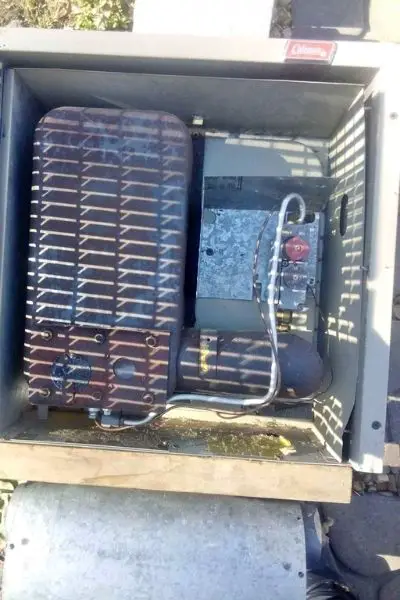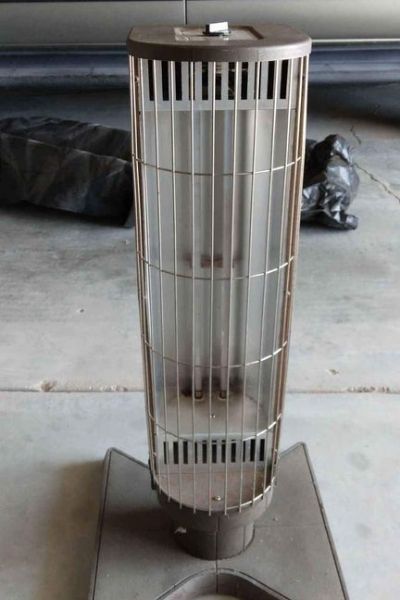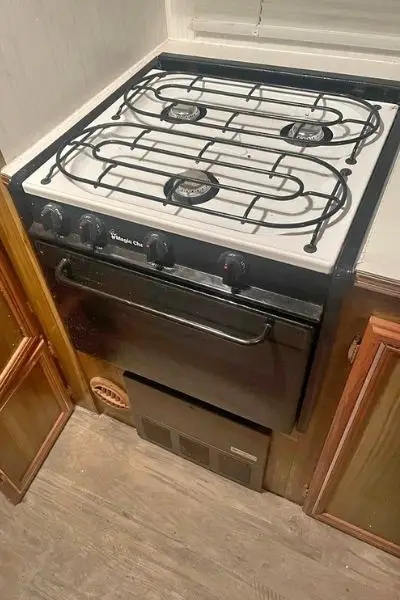Heaters in your RV are critical to maintaining comfort and safety when camping in cooler temperatures. Unfortunately, a heater can contribute to adding moisture to the air in your RV. Moisture in your RV can become a serious issue when the outside temperature drops.

The air in the small interior space can quickly become saturated. The high interior moisture levels will allow condensation to form on the RV’s exterior walls and windows. Excessive condensation can lead to water damage and mold growth, both of which are serious issues for RVs.
Controlling interior humidity in an RV during colder weather can be a tough battle. One key fight in that battle is to identify sources of moisture that will add to the problem. By eliminating sources of new moisture, controlling humidity levels becomes easier. One of the primary sources of new moisture is heaters. Let’s take a look at what types of heaters add moisture to your RV, and which ones don’t.
Do Vented RV Furnace Heaters Add Moisture To The Air?
Vented RV furnaces do not add moisture to the air due to the separation of the heat exchanger and the burning chambers inside the furnace. The combustion of fuel does generate water which is released into the air.

Inside a vented RV furnace, that combustion occurs in a combustion chamber that is separated from the interior air space of the RV. Furthermore, that combustion chamber is vented to the outside of the RV via forced air fans. This design is really set up to prevent dangerous gasses like carbon monoxide from mixing into the RV’s interior air.
RV furnaces have multiple safety mechanisms built into them to ensure the furnace will only run when these gasses can be safely forced outside. An added benefit to this setup for our moisture control efforts is that any water generated by the combustion process is forced outside of the RV as well.
Do Diesel Air Heaters Also Produce Moisture?
Diesel air heaters work in much the same way as your vented propane furnace so they will not add moisture to the air. For safety reasons, these units use a heat exchanger to separate the combustion process from the cabin air they are heating.

Since the two don’t mix, the moisture generated by burning the fuel remains separated from the heated air. The moist combustion air goes outside, the warm air is circulated back into the RV with no moisture added.
Do Electric Space Heaters Produce Moist Heat?
Electric space heaters do not produce any moisture as they heat. Electric space heaters generate heat by passing electricity through a high resistance wire or material which causes it to heat up. Some heaters have fans to force air through and spread it around the area, others rely on convection.

Regardless of how the heat is distributed, there is no combustion taking place so there is no moisture produced. This makes electric heaters a great choice to heat your RV while controlling the humidity in your rig.
Do Buddy Heaters Produce Humid Heat?
Buddy heaters work by burning fuel to generate heat so they will also generate moisture. These units, when operating correctly, have an exceptionally efficient combustion system. This means that nearly all the fuel is burned down to produce just carbon dioxide and water.

Dangerous gas byproducts like carbon monoxide are produced in such small quantities that Buddy Heaters are considered indoor safe without direct ventilation. Even so, these units should never be used with no ventilation for two reasons. First, the key factor in the description above is that they are safe when working correctly.
If they malfunction for any reason, they can quickly become dangerous without you realizing it until it’s too late. You can read more about this in an article on the dangers of using a buddy heater. Second, since they do add moisture to the air you will want to have some outside ventilation to prevent that moisture from building up and becoming a problem.
So What Appliance Adds Humidity To The Air Of Your RV?
Moisture buildup, or high indoor humidity, can be attributed to two main sources in your RV: People and the propane stove. People add humidity in two ways. First, we all generate humidity by breathing, and in the small interior space of an RV that breathing can significantly raise the humidity level. This is especially true during colder weather when we tend to spend more time inside. The more people you have in your RV, the bigger an issue this becomes.

The second human contribution to RV humidity levels is our activity. Showering is a big contributor, as are cooking and doing dishes. Anything we do with water or burning open propane flames inside the RV will raise the interior humidity levels.
Cooking on the propane stove can be a double whammy. The combustion of the propane itself generates moisture. The amount of moisture produced can be quite high since cooking can take a long time. To add to that, we rarely cook anything that’s totally dry even if you couldn’t tell by tasting it. Boiling water is a huge moisture contributor, but even roasting meats or vegetables will release a fair amount of water into the air.
So How Can You Reduce The Humidity In The Air Of Your RV?
There are several ways you can reduce the humidity in your RV. These can be broken down into two prongs of attack: Minimize the creation of new moisture and remove the moisture that is already there. Let’s take a look at some options in both categories.
Things you can do to minimize new moisture in your RV.
- Don’t cook on the propane stove or in the propane oven.
- Keep cooking vessels covered to keep moisture in.
- Take short showers or shower at the campground bathhouse.
- If your RV has one, open the bathroom vent cap and turn on the fan while showering.
- Close the bathroom door while showering to prevent the moisture from escaping into the rest of the RV.
- Don’t run any combustion heaters that are not vented outside.
- Don’t leave standing water in the sinks.
- Minimize your use of hot water.
- Keep doors open throughout the RV, particularly your bedroom door at night. This will prevent the buildup of humidity from breathing in the smaller confined rooms.
Things you can do to remove moisture in your RV.
- Crack open a window or roof cap.
- Run your stove vent hood fan while cooking on the propane stove. Make sure the exterior hood flap is not in the locked/travel position so the air can properly escape.
- Use a dehumidifier.
The most efficient way to control the humidity levels in your RV is with an electric residential compressor-style dehumidifier. These are generally rated for square feet, or in pints of capacity. Most compressor-style units are good for 1000 square feet and up.
You’ll need that much capacity to keep the humidity in check with a single unit in most RVs. We use a 30 pint, 1500 square foot unit in a 37-foot travel trailer with 3 slides (about 350 sq feet) and it will keep the humidity levels at or below 30% with six people in the RV. Running full time, it only has to be emptied every 12 hours so we can conveniently empty the bin in the morning and in the evening.
It’s also small enough that it can be stored in a standard RV closet and quiet enough that it doesn’t bother us when it’s running. I would recommend going this route if you plan to spend a lot of time RVing in temps below 50 F. The units from Homelabs are a solid choice.
There are smaller, cheaper, and quieter dehumidifiers available, but you’ll likely need more than one to cover all but the smallest RVs. Most of these work on the Peltier Effect, which is an electrical phenomenon that silently generates hot and cold surfaces simply by applying an electric current.
The cold surface will collect condensation and dehumidify the air. While the process is energy efficient, it doesn’t work well on a large scale so this style of dehumidifier is usually limited to spaces under 300 sq feet. For a small RV that may be enough. For larger RVs, you may need one per room. Scanning through some units on Amazon shows that the ProBreeze units are well rated.
If you are only having humidity issues in very small specific spaces then you may be able to get away with a desiccant-based dehumidifier. These contain media that absorbs water from the air. That media usually changes color when it’s used up so that you can then either replace the media or regenerate it depending on the type of unit you have.
The units from Eva-Dry are the most popular in the RV community. They have built-in regeneration (just plug them into a standard outlet for a few hours), are inexpensive, and do a great job controlling the humidity in small spaces like pantries and closets.





